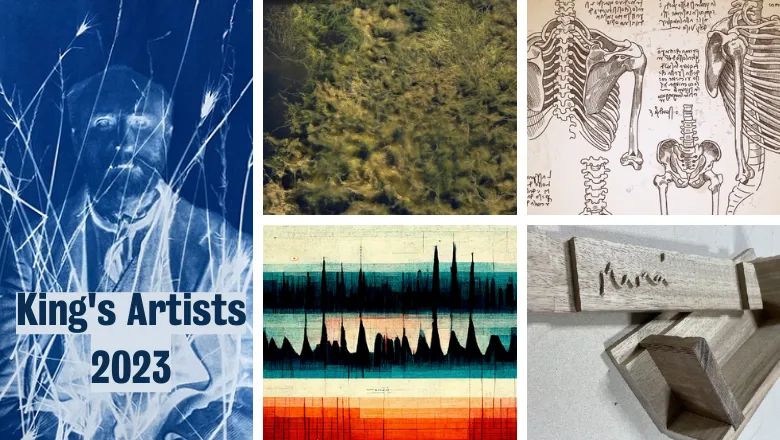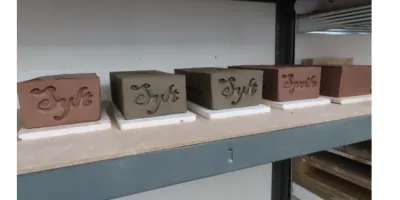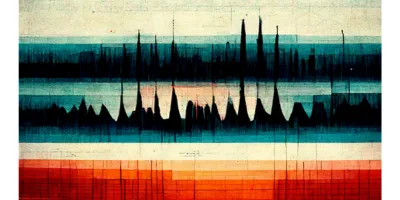21 August 2023
Deep dive into the 2023 King's Artists Programme
Sinead Campbell
As this year's King’s Artists programme concludes, discover more about this year's 6-month research and development collaborations, supported by King's Culture

King's Artists
In January 2023, King’s Culture announced the participants of the 2023 King’s Artists cohort, which would see collaborative research and development projects awarded six-month research and development (R&D) grants, with the aim of fostering academic and artistic exchange.
Since launching at the beginning of the year, the five collaborations involved in the 2023 King’s Artist residences have been making progress on their various projects. With support from King’s Culture , the project teams have utilised their collaborations to develop projects which span across topics including mental health, finance and environmentalism. The final outcomes have produced work which engages students and researchers at Kings with wider artistic practices and academic insights.
As this year's programme comes to an end, we catch up with the artists and academics involved to find out what they have produced as part of their residencies, their thoughts and reflections on the process as well as their plans for the future.
Alicia Britt & Jon Armstrong in the School of Medical Education
Alicia Britt and Jon M Armstrong have been collaborating with Dr Alex Mermikides D'Oyly Carte, Senior Lecturer in Arts and Health in the GKT School of Medical Education. Their project, 'Drama of Dissection', explores the use of performance magic and puppetry in teaching human skills and the human body to biomedical and medical students. The project team have been testing their findings in workshops with bioengineering students as part of their curriculum.
So far, the team have launched the beginnings of their project at the Science Gallery London in March, working with performers to showcase their work to an audience of students, other academics, medical professionals and the general public. They are planning to use this performance as part of teaching next year, in the hopes of transforming it into a programme that can be rolled out to anatomy departments across the country.

Léonie Hampton in the Department of Geography
Léonie Hampton has been working in collaboration with Dr Jane Catford, Reader in Ecology and her research team in the Department of Geography. Together, they have been developing ‘Beyond Triffids’ - a project exploring perceptions of human and plant “nativeness” in relation to biodiversity and climate crises.
Since beginning the residence, the project team has expanded, now including Dr Rowan Rose Boyson, Reader in Eighteenth-Century and Romantic Literature and Research Fellow at King’s as well as multi-media artist Cliff Hammett, whom Léonie met after attending the Environmental Humanities Research Network meeting. Léonie and Jane also spoke at the Thelma Hulbert gallery in March where Léonie’s work was displayed. Reflecting on the process thus far, Léonie has said: ‘The residency has shifted my perspective on invasive science. I’m excited to further expand the research and work on an artwork that best encapsulates the fear we hold around questions of invasion'.

Kathryn Maguire in the Department of English
Kathryn Maguire has been working in King’s English Department, collaborating with Dr Jemima Matthews, Lecturer in Early Modern English Literature. Their project, titled ‘Silt and Other Matters’, explores the rich history and possible futures of riverine and estuarine matter. Using London and the River Thames as their geographical focal point, Kathryn and Jemima have embarked on combined research, looking closely at the composition of silt and clay, uncovering the intersection between materiality, ecology and linguistics in early modern England. Together, they have produced a series of inscribed brickwork, as well as delivering a series of workshops, first with students to generate words representing the Thames to be inscribed onto the bricks, then with researchers across King’s in similar fields to generate wider connections for the project.
The project team are planning to develop a performance piece which will involve a journey to the River Thames from King’s. They are also hoping to hold an exhibition showcasing artefacts and the bricks that were made during the residency

Dr Eric Fong in the Department of Liberal Arts
Dr Alana Harris, Reader in Modern British Social, Cultural and Gender History and Head of the Department of Liberal Arts and Eric Fong are continuing their work on the project ‘Cyanotype Portraits’, exploring the cross-section between local history and the politics of mental health. Through their collaborative research, they have produced cyanotype photographic prints, using the portraits of psychiatric patients buried in Horton Cemetery in Epsom, Surrey. As part of the process, a series of workshops were held in the Liberal Arts department, connected to a larger initiative at Horton Cemetry called ‘Out of Sight, Out of Mind’, encouraging King’s undergraduate and research students to engage with the history and experiences of mental health through activities such as cyanotype printing and ceramic flower painting. The geographical site has gone onto play an integral role in the project, leading Eric Fong to incorporate film and sound recordings of the cemetery to create a large-scale multi-screen installation.
Remarking on the collaborative process and thematic composition of their work, Dr Harris has described the project as an ‘activist anachronism’, using art as a vehicle to consider the link between the state mental health in the past and present. A memorial event will take place on the 10th of October later this year at Horton Cemetery in Epsom, revisioning the life histories of patients and showcasing the research and artwork produced as part of the residency.

Jamie Perera in the King’s Business School and Department of History
Artist Jamie Perera collaborated with Dr Catherine Tilley, Lecturer in Business Ethics & Sustainability, King’s Business School and Dr Chris Manias, Senior Lecturer in the History of Science & Technology, Department of History.
Together, they have been working on their project, ‘Sonifying LSX’, a sound installation which aims to sonify the London Stock Exchange using sounds from organisms in the history of human and animal evolution which are extinct, or in danger of being so. Throughout the residency, the collaborators have used sound to develop a vocabulary to reflect on the legacies of colonialism, consider how we remember the past and can begin to imagine the future. The project entailed a series of workshops incorporating student’s contribution to sound interpretation of the FTSE 100 index. These workshops offered a new perspective which combined the worlds of art and academia, described by Jamie Perera as an experience which ‘empowered students to voice their opinions on destructive social structures in industrial and natural environments’.
Reflecting on the experience, Chris commented on the ‘rewarding’ opportunity to collaborate across departments and with King;s Culture, emphasising the value of working with new people across artistic and academic disciplines. Moving forward, the project team are looking to expand their empowerment initiative to host more sonification workshops at the Science Gallery London, engaging both internal students at King’s and the wider public.

The history of the programme
The 2023 King's Artists cohort are part a prestigious group of previous King’s Artists and build on the university’s long history of hosting and working with artists across its faculties and within its wide range of research areas.
Over the last decade, more than 75 artist residences have connected academic research with art through a range of media including painting, printing, literature, theatre, music, performance, installation, photography, video, textiles, waxwork modelling, ceramics and fashion. Many of the artists and academics have presented the work and research developed at King’s during residencies on national and international platforms.






